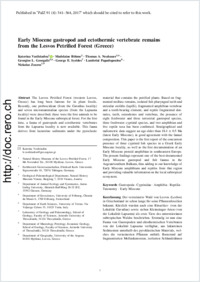Early Miocene gastropod and ectothermic vertebrate remains from the Lesvos Petrified Forest (Greece)
- Vasileiadou, Katerina Natural History Museum of the Lesvos Petrified Forest, Mytilene, Greece
- Böhme, Madelaine Fachbereich GeowissenschaftenEberhard Karls Universität Tübingen, Germany
- Neubauer, Thomas A. Geological–Paleontological Department, Natural History Museum Vienna, Austria - Department of Animal Ecology and SystematicsJustus Liebig University, Giessen, Germany
- Georgalis, Georgios L. Department of GeosciencesUniversity of Fribourg, Switzerland - Department of Earth SciencesUniversity of Torino, Italy
- Syrides, George E. Laboratory of Geology and Palaeontology, Aristotle University of Thessaloniki, Greece
- Papadopoulou, Lambrini Department of Mineralogy–Petrology–Economic Geology, Aristotle University of Thessaloniki, Greece
- Zouros, Nickolas Natural History Museum of the Lesvos Petrified Forest, Mytilene, Greece
-
01.12.2017
Published in:
- PalZ. - 2017, vol. 91, no. 4, p. 541–564
English
The Lesvos Petrified Forest (western Lesvos, Greece) has long been famous for its plant fossils. Recently, one proboscidean (from the Gavathas locality) and seven micromammalian species (from the Lapsarna locality) were described; these were the first animals to be found in the Early Miocene subtropical forest. For the first time, a fauna of gastropods and ectothermic vertebrates from the Lapsarna locality is now available. This fauna derives from lacustrine sediments under the pyroclastic material that contains the petrified plants. Based on fragmented mollusc remains, isolated fish pharyngeal teeth and utricular otoliths (lapilli), fragmented amphibian vertebrae and a tooth-bearing element, and reptile fragmented dentaries, teeth, osteoderms and vertebrae, the presence of eight freshwater and three terrestrial gastropod species, three freshwater cyprinid species, and two amphibian and five reptile taxa has been confirmed. Stratigraphical and radiometric data suggest an age older than 18.4 ± 0.5 Ma (latest Early Miocene), in good agreement with the faunal composition. This paper is the first report of the concurrent presence of three cyprinid fish species in a Greek Early Miocene locality, as well as the first documentation of an Early Miocene proteid amphibian in southeastern Europe. The present findings represent one of the best- documented Early Miocene gastropod and fish faunas in the Aegean/southern Balkans, thus adding to our knowledge of Early Miocene amphibians and reptiles from that region and providing valuable information on the local subtropical ecosystem.
- Faculty
- Faculté des sciences et de médecine
- Department
- Département de Géosciences
- Language
-
- English
- Classification
- Palaeontology
- License
-
License undefined
- Identifiers
-
- RERO DOC 306233
- DOI 10.1007/s12542-017-0352-x
- Persistent URL
- https://folia.unifr.ch/unifr/documents/306172
Statistics
Document views: 113
File downloads:
- pdf: 513
